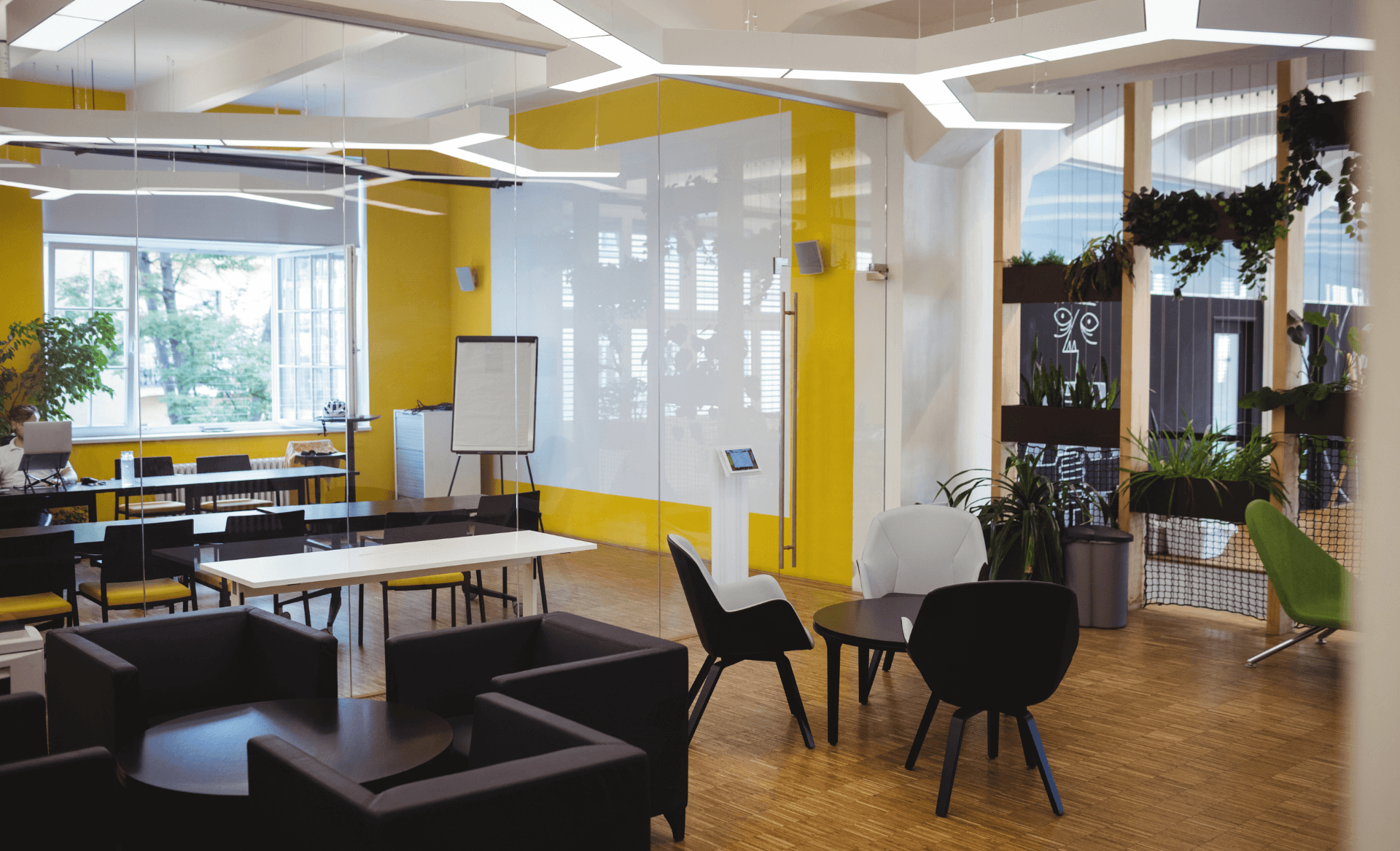Office Lighting How to Improve Employee Well-being and Productivity

In today’s fast-paced work environment, office lighting plays a crucial role in enhancing employee well-being and productivity. While often overlooked, the quality and design of lighting in the workplace can significantly impact how employees feel and perform. This blog post will explore various aspects of office lighting, including its effects on productivity, the best practices for choosing the right lighting solutions, and innovative ideas to create an efficient and comfortable work environment.
In this blog, iSpace Office will bring you up-to-speed on all things that light up your workspace.
The Impact of Office Lighting on Productivity
It’s no secret that lighting in the workplace can influence productivity levels and mood. Numerous studies have shown that the type and quality of light can affect mood, energy levels, and overall job performance. One key aspect to consider is what color light increases productivity. Research suggests that blue-enriched light can boost alertness by lowering melatonin and improving cognitive performance, making it ideal for work environments where concentration and attention to detail are paramount. Conversely, warmer light colors can create a more relaxed atmosphere, suitable for break areas or spaces meant for unwinding.
Types of Office Lighting
Understanding the different types of office lighting is essential for creating a well-lit and productive workspace. The three primary types of lighting include:
- Ambient Lighting: This general illumination fills the room, providing overall visibility. It sets the tone for the entire space.
- Task Lighting: Focused lighting that illuminates specific work areas, such as desks or workstations, helping employees perform tasks more efficiently.
- Accent Lighting: Decorative lighting that highlights particular features or areas within the office, adding depth and interest to the overall design.
The best office lighting solutions incorporate a combination of these types to create a balanced and functional environment.
Office Lighting Ideas for a Productive Workplace
Implementing practical office lighting ideas can enhance both employee well-being and productivity. Here are some suggestions:
- Maximize Natural Light: Whenever possible, take advantage of natural light. It has been proven to improve mood and energy levels. Position desks and workstations near windows to allow employees to benefit from daylight.
- Use LED Lights: Modern office lighting solutions often include LED lights, which are energy-efficient, provide excellent illumination, and have a longer lifespan than traditional bulbs.
- Adjustable Task Lighting: Provide employees with adjustable task lighting at their workstations. This allows them to control the light intensity based on their needs, reducing eye strain and fatigue.
- Light Placement: Position lights to minimize glare and shadows. Proper light placement elevates your office space and ensures that work areas are well-lit without causing discomfort.

Choosing the Right Light Color
Different light colors can impact mood and productivity. When deciding on office lighting, it’s essential to consider the function of each space and choose the appropriate light color. Here’s a guide to help you decide:
- Cool White Light: Ideal for areas requiring high concentration and focus, such as meeting rooms and workstations. Cool white light can increase alertness and productivity.
- Warm White Light: Suitable for relaxation areas, such as lounges or break rooms. It creates a cozy and comfortable atmosphere, helping employees unwind.
- Natural Light: Incorporate as much natural light as possible. It’s the best option for overall well-being and productivity.

By understanding what color light increases productivity, you can tailor the lighting in your office to meet specific needs and enhance performance.
Common Lighting Mistakes and How to Avoid Them
While good lighting can boost productivity, poor lighting choices can have the opposite effect. Here are four common lighting mistakes and how to avoid them:
- Extremely Bright Light: A disadvantage of extremely bright light is that it can cause glare and eye strain, leading to discomfort and decreased productivity. Opt for balanced lighting that provides adequate illumination without being overpowering.
- Inadequate Task Lighting: Ensure that task lighting is sufficient for detailed work. Underlit work areas can cause eye fatigue and reduce efficiency.
- Ignoring Natural Light: Failing to utilize natural light can result in a dull and uninspiring work environment. Incorporate natural light into your office design whenever possible.
Energy Efficiency and Sustainability
In today’s eco-conscious world, it’s essential to consider energy-efficient and sustainable lighting options. These solutions benefit the environment and can reduce operating costs.
Here are some energy-efficient office lighting ideas:
- LED Lights: As mentioned earlier, LED lights are popular for their energy efficiency and long lifespan. They consume less power and generate less heat compared to traditional bulbs.
- Smart Lighting Systems: Modern office lighting can be automated to adjust based on occupancy and natural light levels. This ensures that lights are only used when needed, reducing energy consumption.
- Sustainable Materials: Choose lighting fixtures made from sustainable materials. This not only reduces environmental impact but also supports eco-friendly workplace practices.

Innovations in Modern Office Lighting
Advancements in technology have brought about exciting innovations in modern office lighting. Here are some trends to consider:
- Smart Lighting Systems: These systems allow for automated lighting control, adjusting based on occupancy, time of day, and natural light levels. Smart lighting can enhance comfort and productivity while reducing energy consumption.
- Human-Centric Lighting: This approach focuses on the well-being of employees by mimicking natural light patterns. Human-centric lighting can improve mood, sleep quality, and overall health.
- Wireless Lighting Controls: Wireless controls offer flexibility in managing lighting settings.
Employees can adjust lighting through apps or remote controls, creating a personalized workspace.
Creating a Lighting Plan for Your Office
Developing an effective lighting plan is crucial for optimizing office lighting. Here’s a step-by-step guide to help you create a comprehensive strategy:
- Assess Current Lighting Conditions: Evaluate the existing lighting setup and identify areas that need improvement.
- Determine Lighting Needs: Consider each space’s function and specific lighting requirements. For example, workstations may need task lighting, while meeting rooms benefit from cool white light.
- Choose the Right Fixtures: Select lighting fixtures that meet your needs and align with your design aesthetic.
- Implement Energy-Efficient Solutions: Opt for LED lights and smart lighting systems to enhance efficiency and sustainability.
- Conduct a Lighting Audit: Regularly review and adjust your lighting setup to ensure it continues to meet your office’s needs.
Case Studies and Real-Life Examples
Case Studies and Real-Life Examples
Tech Company A: This company revamped its office lighting by incorporating natural light and LED lights. The result was a 20% increase in employee productivity and a significant reduction in energy costs.
Design Firm B: By implementing human-centric lighting, this firm reported improved employee well-being, with staff experiencing better mood and sleep quality.
These examples highlight how thoughtful lighting design can lead to tangible benefits in the workplace.
Use Office Light to your Advantage with iSpace Office
In a nutshell, office lighting is vital to a productive and healthy work environment. By understanding the impact of different light colors, avoiding common mistakes, and implementing energy-efficient solutions, you can create a workspace that enhances both employee well-being and productivity. Consider the innovative trends in modern office lighting and develop a comprehensive lighting plan tailored to your office’s needs.

At iSpace Office, we specialize in creating optimized work environments through effective lighting solutions, office furniture, ergonomic analysis, and space planning. Contact us today to learn how we can help transform your office with the best lighting ideas and optimize your Indianapolis office lighting to improve employee well-being and enhance productivity. Call (317) 666-9562.
